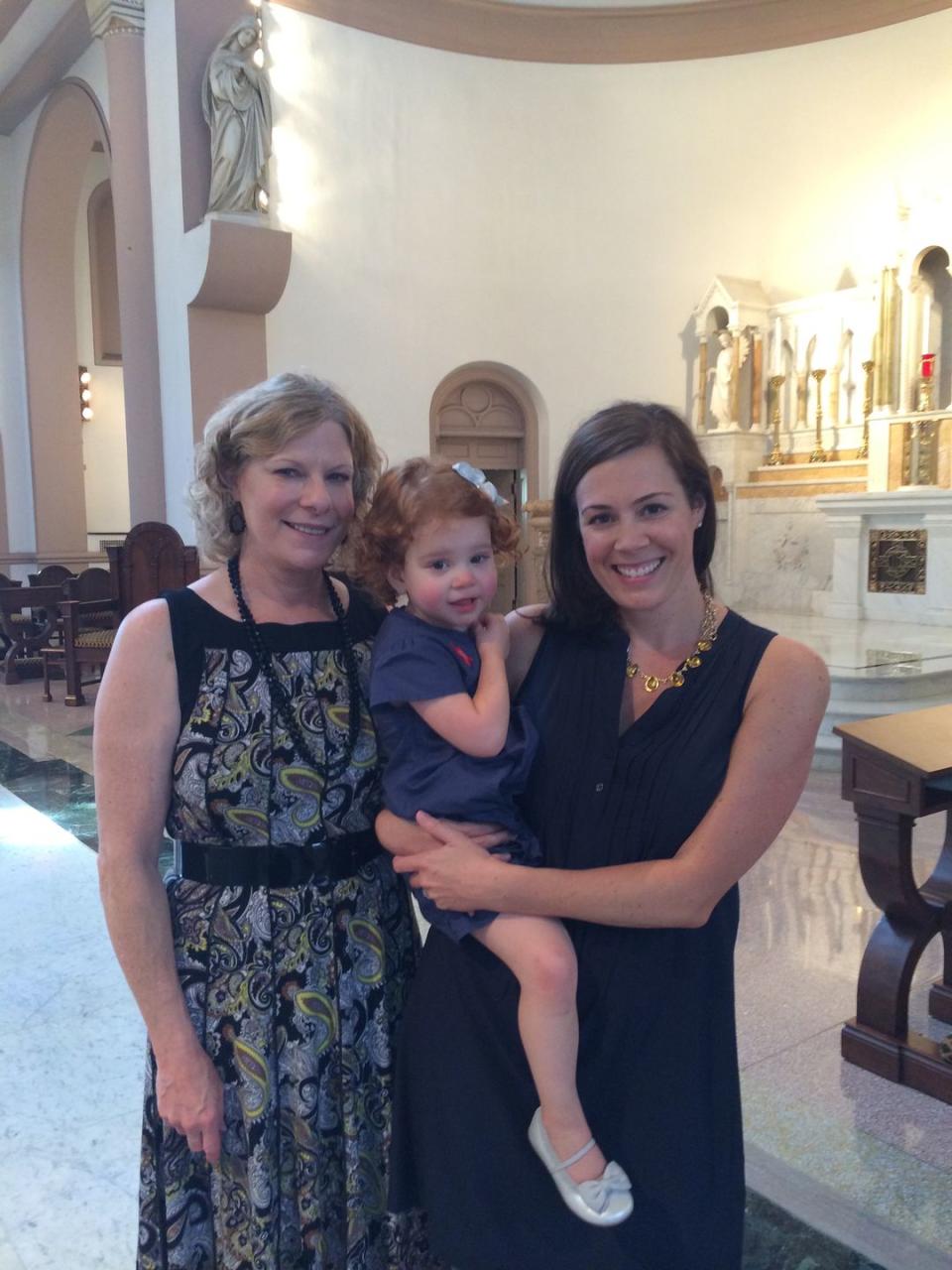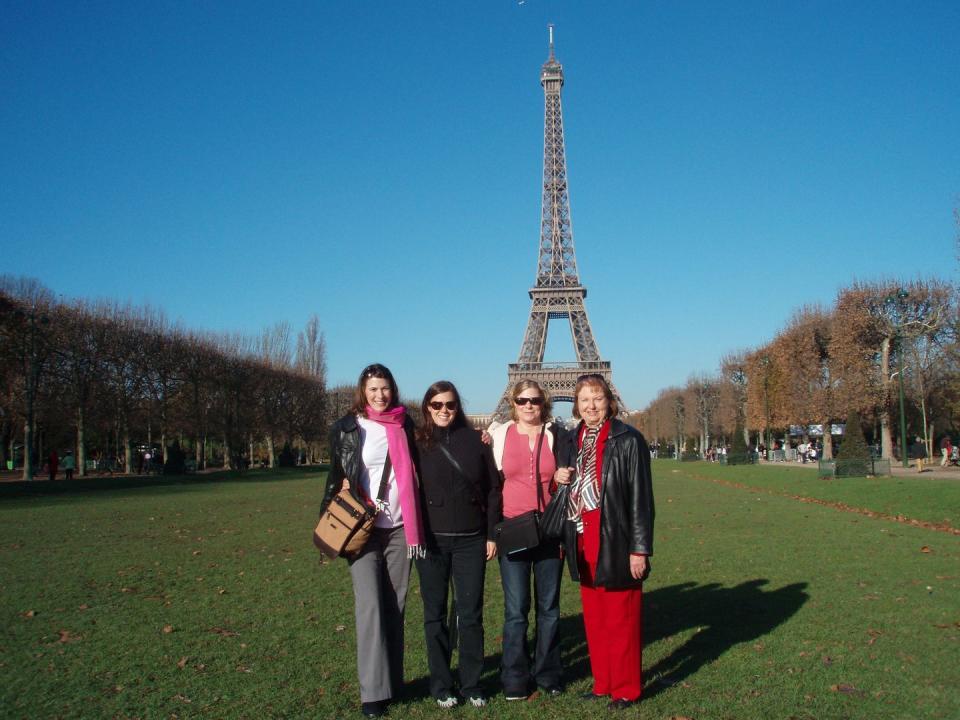I Thought My Mom Was Just Clumsy. Turns Out She Has This Disease.

Content Sponsored by Amgen.
Tallying up the bones that Claudia Kaufman has fractured is no easy task. She's broken her foot, her wrist, and her right shoulder—all by the age of 59.
Despite considering herself an active mom and grandma (who adores playing with her two daughters' kids), Claudia's injuries happened in ordinary, everyday moments. In other words, she wasn't skiing treacherous slopes or hiking steep paths.

In fact, Claudia had so many injuries that her family adopted a bit of a "here we go again" attitude, remembers Monica, one of Claudia's two daughters. "My sister and I, and probably my grandmother and my stepdad, would think, why is she always breaking things?" she says.
There was a simple explanation for Claudia's many fractures: Post-menopausal osteoporosis, a chronic and progressive disease that results in weakened, fragile bones.
Osteoporosis is the most common bone disease, affecting about eight million women. The stats are sobering: Nearly half of all women over the age 50 in the U.S. will break a bone due to the condition.

Bone density loss cannot be seen or felt, so for some people breaking a bone is the first sign of osteoporosis. Many women in the U.S. are underdiagnosed and undertreated for the disease, which was true for Claudia. This may be because osteoporosis is not always top of mind with other health concerns looming. However, it is important that postmenopausal women make bone health one of their health priorities. One way to do so is to ask your doctor about getting a bone density scan (also known as a DXA scan) which is used to diagnose osteoporosis.
A study has shown that fewer than 20% of women in the U.S. receive treatment for osteoporosis even after breaking a bone. Unfortunately the connection between Claudia’s fractures and a diagnosis of postmenopausal osteoporosis was not made right away.
A slip-and-fall on the sidewalk led to one of Claudia's worst fractures. "It just completely shattered my right shoulder humeral head, which was awful," Claudia says.
Many women think that they are just clumsy, but this is not the case. A slip or fall from standing height should not cause a broken bone. If you break a bone from standing height, it is typically a sign of osteoporosis.
After her fall, it was impossible for Claudia to do everyday activities on her own (think: showering, cooking dinner, dressing, and so on), so her two daughters, Monica and April, took turns helping out.
Monica rushed down from Boston to D.C. to be by her mom's side. "My mom was really incapable of taking care of herself," Monica says.
Although she was happy to be there for her mom, being the primary caregiver didn't come without it's challenges—especially since Monica has a high-pressure, full-time job and a family of her own. "It added another layer of stress," she says. Eventually, it was April's turn to take over.

"I didn't realize at first how bad it was," says April. Claudia was "in so much pain, and unable to do really basic things," she remembers. But Claudia was also independent, and her injuries were so sudden that caring for their mom felt jarring and awkward to Monica and April.
"As a young person, you may expect to help your parents when they get older, but you don't put too much thought into how you will have to help them and when that time will come—it can feel as if it will be far off in the future," says April. "I didn't expect to have to help my otherwise healthy, active, then 50-something-year-old mother go to the bathroom or take a shower and as a parent, you don't want to need that kind of help from your child, either."
"Bathing your mom when she’s in her fifties and still a capable adult is bizarre and emotional for both of you," says Monica.
"Honestly, it was really hard for both of us," says April.
After her daughters left, Claudia's 80-year-old mother Rosie flew out to D.C. to help her with everyday tasks, like driving her to and picking her up from work. "I'm very fortunate my mother was healthy enough to fly out to D.C. to care for me, and that my daughters were willing to take time away from their jobs and families as well," Claudia admits. "I don’t like to burden my family or rely on others, but at the time I didn't have a choice."
"When she got her postmenopausal osteoporosis diagnosis, it was a relief and a weight lifted off her shoulders," says Monica. Finally, there was an explanation for those fractures that wasn't just a combination of poor luck and klutziness.
After experiencing full body discomfort due to fibromyalgia, Claudia saw a rheumatologist, who ran nearly every test under the sun. He suggested she get a DXA, or bone scan, which is when she found out she had post-menopausal osteoporosis, says Claudia.
“Too many women with osteoporosis go undiagnosed and untreated, putting them at risk for breaking a bone, or even multiple bones,” said Dr. Michele McDermott, Medical Director at Amgen. “It is crucial for women to take charge of their health and talk to their doctor about a bone health plan to help them lower their risk of fracture.”
Although osteoporosis is a chronic condition with no cure, once diagnosed it is treatable. Lifestyle changes like regular exercise and a healthy diet are important for bone health, but for women with osteoporosis further treatment with prescription medications is often warranted to help them reduce the chance of breaking a bone.
Since Claudia started taking treatment for post-menopausal osteoporosis, her bone density has increased.
When she was first diagnosed, Claudia's bone density was very low and within a very short time of going on therapy, she experienced a rib fracture during a deep-tissue massage. So with a heightened awareness of her bones fragility, Claudia is a bit more cautious in her behavior. "I find myself looking down at the ground when I'm walking to avoid tripping and falling," says Claudia.
Despite having post-menopausal osteoporosis, now that she is on treatment and her every two-year bone scans show improvement in bone density, Claudia continues to stay active and especially enjoys time spent at the beach with her children and grandchildren. "I'm not someone who just sits around and does nothing. I go all the time because I love it," says Claudia. "I'm very active."
An active, beach-loving grandmother might not be what you imagine when it comes to post-menopausal osteoporosis. That was true for Claudia's daughter, Monica: “I just think of people with a hunched back," she says of her impression of the condition before her mother's diagnosis.
Dispel that image, which may stand in the way of getting an appropriate diagnosis and timely treatment. Claudia, after all, is far from frail, as April notes—she was healthy and worked out regularly with a personal trainer and still wound up having frequent fractures. "That's not normal," says April, adding that it's frustrating it took so long to diagnose Claudia with post-menopausal osteoporosis.
Today, Claudia and her daughters are big advocates for everyone to take care of their bones. "You need to watch out for your own healthcare," Claudia says, asking about scans (especially if you fracture a bone) and following up on the results once they're available.
"You know your body, you know yourself more than anyone else," says Monica. "Don't be afraid to ask pointed questions. If something's not feeling right to you, then do whatever you can to get to the bottom of it."
For postmenopausal women, tracking your bone density should be one of your health priorities—that way, you can be aware of any decrease in density and work to help stop it in its tracks (or even help reverse the trend). The National Osteoporosis Foundation (NOF) recommends that women over age 65 get a bone density scan. But age isn't the only reason to request a scan—NOF also recommends getting one if you lose half an inch of height in a single year or if you break a bone after age 50.
You Might Also Like
